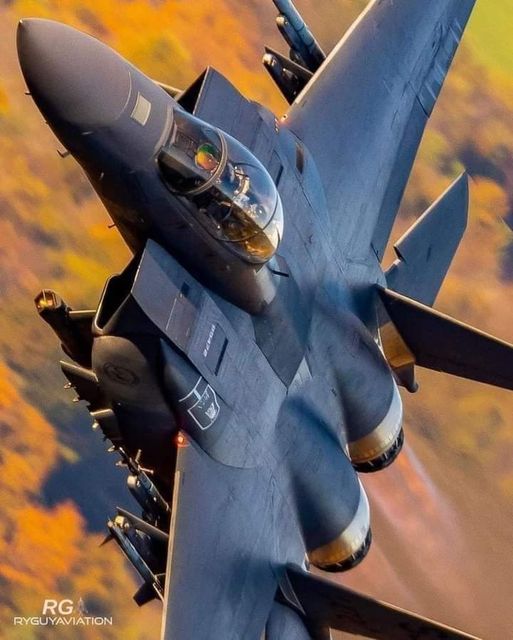The F-15 Strike Eagle was designed as a true-to-form air superiority fighter, with ground attack operations coming in second place in priority.
If you listen to the people in charge of the military-industrial complex, they’ll tell you that the US Air Force is in desperate need of some upgrades. In truth, these people are in the business of selling people military equipment for a profit, whether they’re needed or not. In truth, some of our all-time favorite American fighter jets still have more life left in them than most people will give them credit for. Want proof of this? Look no further than the Mcdonnel-Douglas F-15E Strike Eagle.
Sure, the plane the Strike Eagle is based upon has its roots in the mid-1970s, but it’s so loaded up with the latest and greatest technology, we doubt any uninformed person would be able to tell. So as the Air Force prepares to usher in the sixth generation air superiority fighter sometime in the next decade or so, let’s not forget that there’s still a place in the world for older fighter jets on a modern battlefield.
Think the F-22 Raptor and F-35 Lightning II are useless wastes of money? The F-15’s been blowing enemy aircraft out of the sky since before those planes were even a thought in their designer’s minds.
A Modern Marvel With Origins In the 1970s

The Vietnam War was a crash course in being humble for the U.S. Air Force and taught them many valuable lessons. Chief among things was that the days of direct plane on plane dogfighting were far from over. Relying solely on long-range air-to-air missiles turned out to be a complete disaster in the skies over Indochina. So when the time came to replace the aging F-4 Phantom, a plane that originally didn’t even carry a cannon, something truly spectacular was needed to get things back on track. The result was the original single-seater F-15 Eagle
Initially, the F-15 was designed as a true-to-form air superiority fighter, with ground attack operations coming in at a distant second place in priority. This all changed with the introduction of the upgraded F-15E.

This time around, an integrated laser-guided targeting pod and active electronically scanned array (AESA) radar were introduced to the now two-seater-F-15E. All in conjunction with the plane’s standard avionics courtesy of Raytheon. All of this allows the Strike Eagle to drop a slew of radar-guided bombs, missiles, and other high explosive ordinance ground ordinance over a wide area.

To round things off, the F-15 came with an M61 20-millimeter cannon with 940 rounds of high explosive ammunition. All tied together with the standard Aim-7 Sparrow and Aim-9 Sidewinder air-to-air missiles that have been the F-15’s bread and butter since the very beginning. Suddenly, the F-15 was no longer just a point-and-shoot superiority fighter but a multirole jack of all trades aircraft that could perform just about any mission the military could throw its way.
Making Up For The Failures Of 5th Gen Fighters
If you follow military news as closely as some of us do, chances are you’re sick and tired of hearing about the constant shortcomings and of the latest generation of fighter jets. Whether it’s the F-22 Raptor, the F-35 Lightning II, or even the Russian SU-57 and Chinese J-20. Delays, setbacks, and general mechanical tomfoolery have plagued each of these programs since the very beginning.

Not so with the F-15E. As other jets sit on the ground bogged down in mechanical snafus and budget overruns, the Strike Eagle’s seen successful deployments in every armed conflict the U.S Air Forces has participated in since the 1980s from the Persian Gulf to the War On Terror to the fight against ISIS. F-22’s have taken part in limited ground attack sorties over Syria. The bulk of the heavy lifting for the U.S Air Force is still pulled by the Strike Eagle, even in 2021.
Not Going Anywhere Anytime Soon
 Capt. Matt Buckner, an F-15 Eagle pilot assigned to the 71st Fighter Squadron at Langley Air Force Base, Va., flies a combat air patrol mission Oct. 7 over Washington D.C. in support of Operation Nobel Eagle. (U.S. Air Force photo/Staff Sgt. Samuel Rogers)
Capt. Matt Buckner, an F-15 Eagle pilot assigned to the 71st Fighter Squadron at Langley Air Force Base, Va., flies a combat air patrol mission Oct. 7 over Washington D.C. in support of Operation Nobel Eagle. (U.S. Air Force photo/Staff Sgt. Samuel Rogers)
Amazingly, the F-15 line of fighter jets bridges a nearly 50-year gap between the end of the Vietnam War and the present day. In that time, it’s become the backbone of the U.S Air Force while other longtime mainstays like the F-14 eventually lost the battle with the forces of aging.

Even if the F-15 is well-deserving of an easy retirement, the daily demands of a complex and warfare-filled world necessitate that it indefinitely stay in service. As of 2021, production of the Strike Eagle is expected to end sometime in 2022. Even still, expect these planes to be ready for any conceivable armed conflict the U.S. military could find itself in for decades to come.

Furthermore, the Strike Eagle is already the front-line fighter for many of America’s closest allies like South Korea, Israel, and Singapore, among others. So even if the U.S phase it out, it’s going to be a symbol of strength for armed forces around the world for a long time to come.
 This model is available in multiple sizes from airmodels.net – CLICK ON THE PHOTO TO GET YOURS.
This model is available in multiple sizes from airmodels.net – CLICK ON THE PHOTO TO GET YOURS.
